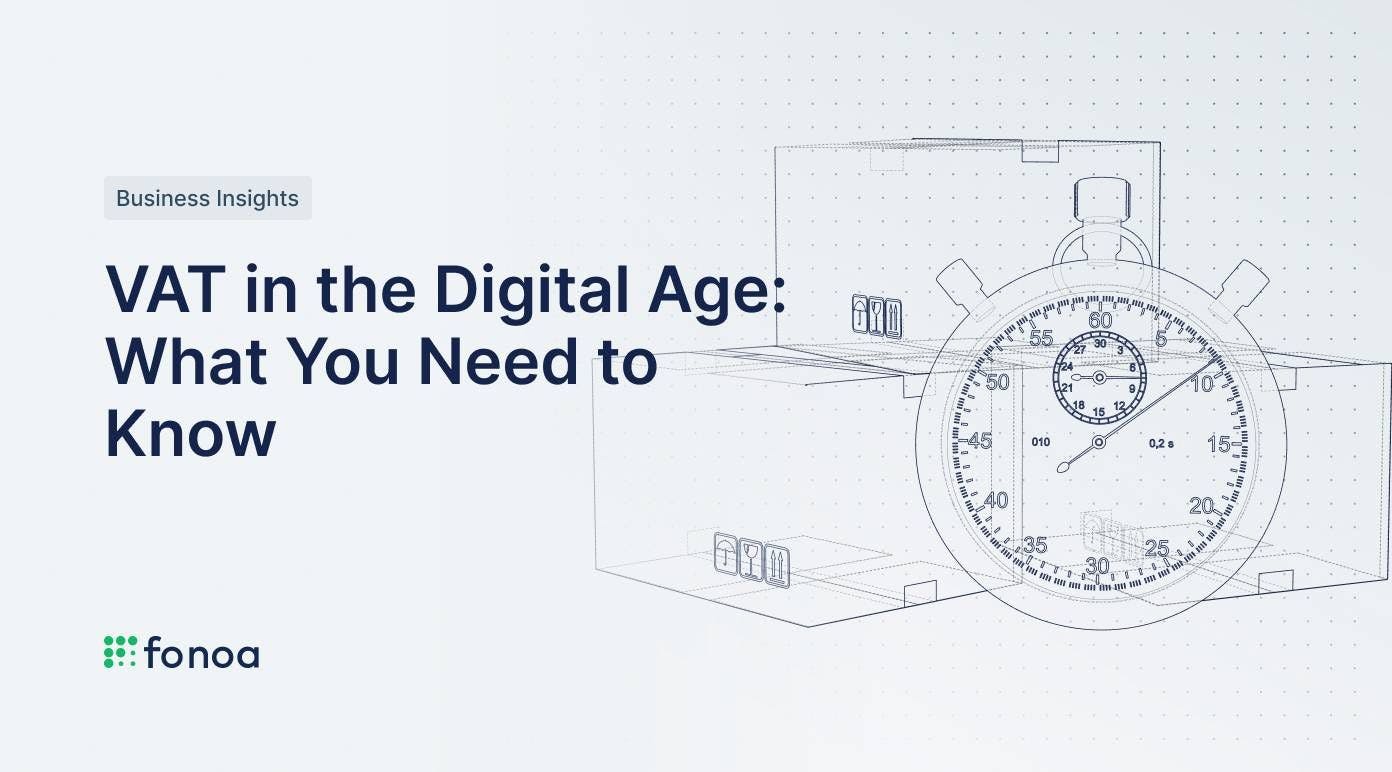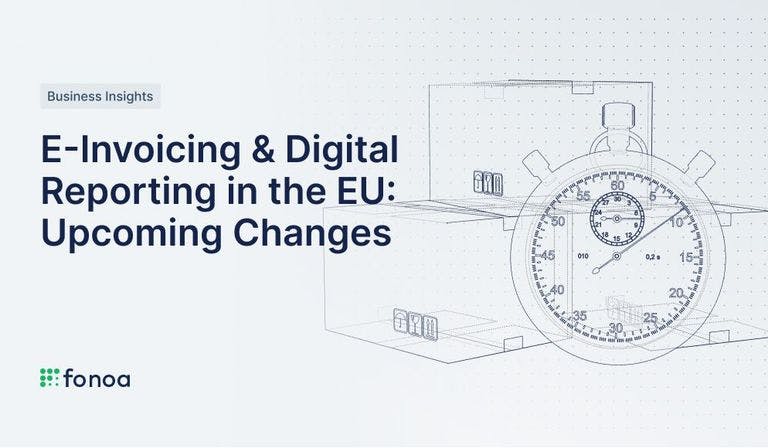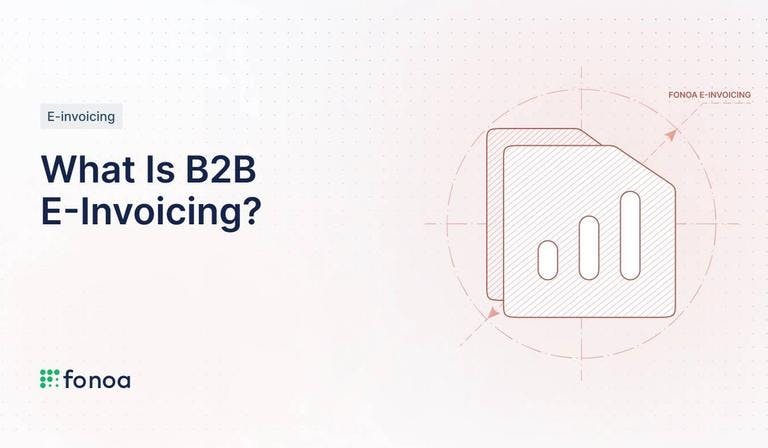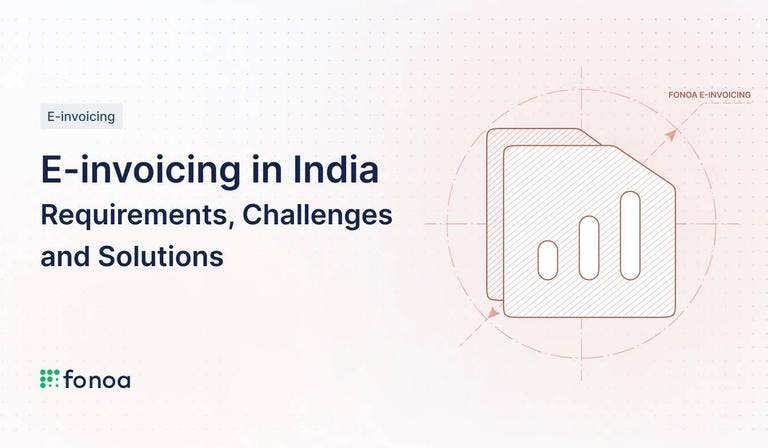VAT in the Digital Age: What You Need to Know

If you’re detail-oriented, this article has everything you need. But if you’re looking for bullet points? 👉Read our key takeaways.
Summary: The Proposal for VAT in the Digital Age
The European Commission’s long-awaited VAT in the Digital Age (ViDA) proposal has finally been announced. Today's package of proposals takes the form of amendments to three pieces of EU legislation: the VAT Directive (2006/112/EC), Council Implementing Regulation (EU 282/2011) and the Council Regulation on Administrative Cooperation (EU 904/2010).
The ViDA initiative is a response to the fast and active digitalization of the economy – like the development of new businesses in the platform economy – and to the new challenges the EU Tax Administrations face as a consequence, like the increased amount of data they now need to collect and manage.
The proposal aims to:
- modernize VAT reporting obligations and facilitate e-invoicing
- update the VAT rules for the platform economy
- move towards a single VAT registration in the EU
At this stage, the proposal affects Platforms and businesses providing services facilitated by the use of a Platform (especially in areas such as transportation and accommodation), whether or not they have a registered presence in the EU, and all businesses performing intra-Community transactions - without any size, industry or threshold limitations.
Businesses have to be prepared to comply with the new Digital Reporting Requirements (DRR), e-invoicing and platform economy rules, which will likely require significant IT investments. Depending upon the level of centralization of the IT infrastructure to be built, businesses may face a long implementation period that requires considerable technical resources.
Background: Development of the ViDA Proposal
The ViDA proposal had a bumpy ride on the way to being published. The initiative started back in 2020, followed by reports on the current situation, Impact Assessments, public consultations, and workshops throughout 2021 and the first half of 2022. And after months of debate and a few weeks (plus one day) delay in publication, the EU Commission finally published a draft proposal on December 8, 2022.
The current EU VAT legislation does not contain any provision referring to DRRs and the treatment of the gig economy. The EU’s VAT legislative framework (1) is unable to deal properly with the new digital reality, (2) is prone to fraud, and (3) has also become increasingly complex and burdensome for businesses. The old VAT rules are not adapted to doing business in the digital age, making overall reform unavoidable.
Ultimately, ViDA was drafted for multiple purposes: to ensure the proper functioning of the single market, tax equality and neutrality, to reduce compliance costs for businesses, and to protect the financial and economic interests of the EU and its Member States. As a consequence of the proposed changes to the EU VAT Directive, EU Tax Administrations will increasingly use digital technologies to increase compliance, more effectively combat tax fraud, and reduce administrative burdens by simplifying tax compliance and reporting. With the help of the initiative and the introduction of new compliance requirements, the VAT Gap is also expected to further decrease, which amounted to 93 billion EUR in 2020 based on the confirmation of Paolo Gentiloni (EU Commissioner for Economy) at the latest Tax Symposium. With the already introduced DRRs and e-invoicing mandates, the VAT Gap has already decreased significantly from 134 billion EUR (data from 2019).
The ViDA Proposal: Transforming VAT in the Digital Age
1st Pillar: VAT reporting obligations and e-invoicing
The EU Commission’s goal in the DRR pillar is to achieve harmonization in terms of Digital Reporting Requirements and an effective VAT control system in the EU. In the report published by the Commission, four different policy options to tackle this issue were discussed and concluded that the best result would be achieved through the introduction of an EU-wide DRR based on e-invoicing. This requires changes in the VAT Directive provisions. In line with this vision, the Commission has proposed the following changes:
Transmission of Information between Member States: The proposal envisages a more sophisticated VAT Information Exchange System (VIES) than the existing VIES system. This will require the development of a new central system by the Commission for the exchange of VAT information between Member States’ tax administrations at the EU level that is adapted to the specificities of new DRRs. The new VIES platform will be able to store, as well as cross-check, aggregate and process the information received. Information will only be stored in the system for five years.
Introduction of an EU-wide real time reporting mandate for intra-community transactions: It will be mandatory for all taxpayers (regardless of their size, industry or annual threshold) to generate an e-invoice for intra-community B2B supplies that then must be reported to the tax authority within 2 working days. B2C transactions will not be included in the scope. Reported transactions must conform to the European E-invoicing Standard (EN-16931-1). After issuance of the invoice, taxpayers must Report (within 2 days) the transaction to their local tax authority. Tax authority platforms will then deliver relevant parts of the e-invoice data to the VIES platform. Recapitulative statements will no longer be needed as all necessary information will be collected through the reporting system.
Member states have the autonomy to decide to enforce domestic transactions to be reported, with the caveat that the domestic obligations must be harmonised with the intra-community obligation. Namely, acceptance of European Standard as one of the permitted formats and that invoices shall not be subject to a prior mandatory authorisation or verification by the tax authorities. Member States can permit the transmission of e-invoices issued in other formats, as long as they at least accept the European Standard. Member States which already have an existing DRR in place will have to adapt them by 2028.
New definition of electronic invoice: The e-invoice is redefined as a structured file. The new definition is in line with Directive 2014/55/EU for e-invoicing in public procurement. This change means that non-structured files such as PDFs will not be considered as an electronic invoice format. The use of paper invoices will only be possible in situations where Member States authorize them.
New invoice content requirements: E-invoices will now include additional data. New fields serve the purpose of fraud detection. Among the new fields are the identifier of the bank account in which the payment for the invoice will be credited, the agreed dates and amount of each payment related to a concrete transaction, and, in the case of an invoice that amends the initial invoice, the identification of that initial invoice
Removal of “Buyer Acceptance”: Article 232 of the VAT Directive (which required recipient’s acceptance for e-invoicing) is proposed to be deleted. This means that Member States will no longer be required to obtain a derogatory decision from the EU Commission to introduce invoicing in their countries.
Deadline for the reporting of e-invoices: E-invoices must be issued two days after the chargeable event takes place. The deadline for reporting intra-community transactions is two working days after the issuance of the invoice, or after the date the invoice should have been issued. If the taxable person has not complied with their obligation to issue an invoice, the transmission of data has to be carried out electronically, and Member States will provide the means for reporting of invoices by taxpayers or by a third party on their behalf.
Elimination of the possibility to issue summary invoices: The proposal explains that the goal of the new reporting system is based on per transaction reporting, therefore it will not be possible to issue summary invoices.
1st Pillar Conclusion
The proposed changes are groundbreaking and have the potential to reshape the European VAT by enforcing standardization and automation for all European taxpayers. It is expected to increase the effectiveness of VAT controls while enabling the use of technology for businesses. The benefits in terms of revenue is expected to be 11 billion EUR per year. The proposal aims at making electronic invoicing the default system for the invoice issuance. However, having different rules for domestic and intra-community supplies would create two different processes to be managed by taxpayers. Considering that the DRR obligations will apply to all taxpayers, the compliance burden for SMEs could potentially create new challenges.
2nd Pillar: VAT treatment of the platform economy
Tackle unfair advantages introduced by the platform economy: Before the advent of the platform economy, VAT-exempt individuals and SMEs did not compete with larger VAT registered businesses. But in the recent decade, technology empowered the rise of new business models, enabling a large concentration of these VAT-exempt individuals and SMEs to compete head on with traditionally run, VAT-registered businesses. This resulted in a perceived unfair advantage for these technology-enabled businesses, which the directive calls “platforms,” as oftentimes they compete with VAT-free prices.
Current rules: In many cases, transactions in the short-term accommodation and passenger transport industries supplied via Platforms are untaxed as they tend to aggregate offerings of VAT-exempt individuals and SMEs. This has become a critical issue for traditional hotel and taxi companies in particular. These industries form the majority of the Platform industry after the sale of goods.
Proposed changes: The ViDA proposal addresses these challenges by introducing deemed supplier obligations for digital platforms that are active in the EU. After the proposed changes are implemented, Platforms will become accountable for the VAT due, while the underlying supplier would be VAT-exempt because they are a small business or an individual provider, for example. “It will also simplify compliance for SMEs and individual users of these intermediaries, in that they will not have to worry about their VAT obligations going forward, because it will be the Platform to do so.” - Said Commissioner Paolo Gentiloni at the press conference introducing ViDA on 8 December 2022.
In addition, the proposal clarifies the treatment of facilitation services. This will allow for a harmonized application of the place of supply rules to handle currently present issues of double- or non-taxation.
The proposal also introduces standardized record keeping obligations on Platforms operating in the short-term accommodation or passenger transport industries. Under these new requirements, Platforms must keep records of transactions they facilitate.
Timelines: The proposed changes under the 2nd pillar shall take effect from 2025.
3rd Pillar: Single VAT registration in the EU
Aim of the proposal: It is a huge administrative and cost burden for businesses to register for VAT in many EU countries separately. One of the three main objectives of the ViDA proposal is avoiding the need for multiple VAT registrations in the EU, and improving the functioning of the already existing One-Stop Shop (OSS)/Import One-Stop Shop (IOSS) systems to declare and pay the VAT. In order to overcome that burden, it has introduced Single VAT Registration (SVR). In brief, the single place of VAT registration means that the obligation for businesses to VAT register in more than one Member State should be minimized, regardless of their operations and supply chains.
Proposed changes: Taking the success of the VAT e-commerce package (introduced in July 2021) into consideration, the ViDA proposal extends the OSS rules as follows:
- broader OSS extension covering the transfer of (own) goods cross-border by e-commerce sellers prior to the B2C e-commerce sale (B2B2C transactions);
- OSS will also cover other own stock movements under a special scheme instead of the so called call-off stock arrangements. Record keeping obligations are introduced for taxable persons using the transfers of own goods scheme;
- under the new rules, zero rated and exempt supplies also need to be reported.
In order to improve the collection of VAT and to combat fraud, one of the measures is to make the IOSS mandatory for certain Platforms facilitating sales to consumers in the EU. Regarding the expected IOSS changes, the current €150 consignment threshold for imported B2C sales will not be raised or abolished in the near future. This change will be postponed until the Customs processes are modified.
Separately, online platforms that facilitate the sale of goods to a final consumer in the EU will become responsible for the collection and remittance of VAT (‘deemed supplier'), whether they are located inside or outside of the EU. Furthermore, platforms will also become the deemed supplier for transfers of underlying suppliers' goods to other Member States, prior to their sale. OSS simplification options are also available for platforms to declare and pay the VAT due on all such supplies.
In addition, under the proposal, companies in one Member State holding stock in another will also be able to sell goods on to another company in the second Member State, where the recipient business will account for VAT in that Member State (according to the reverse mechanism) without the supplier needing to register separately for VAT purposes. Companies in this situation currently have to register for VAT in other Member States just to sell that stock on to another business.
As a consequence, SVR will enable businesses to report and manage their entire VAT obligations through their domestic Tax Administrations, thus the VAT audit process will also be managed by the same Tax Administrations.
Finally, purely B2B transactions are not included for the time being in the changes because of the complexities of the right of VAT deduction and fraud risks.
Timelines: The new rules shall be adopted and published in the law of the Member States and will be applied throughout 2023 and 2025.
What’s next for ViDA proposal implementation?
Now the published ViDA proposal needs to be formally adopted at the European Union level under the ordinary legislative procedures, as it amends existing Union VAT legislation governed by the VAT Directive.
The implementation of the changes on the Member State level is only expected between 2023-2028.
Businesses must be prepared to comply with the new DRRs, e-invoicing and platform economy rules, which will likely require significant IT investments. Depending upon the level of centralization of the IT infrastructure to be built, businesses may face a long implementation period that requires considerable technical resources.
The proposed changes are transforming the European VAT system by moving towards mandatory e-invoicing and real-time digital reporting. These significant and continuous regulatory changes are forcing businesses to move away from reactive or firefighting mode to a proactive approach with proper strategy (and partners like Fonoa) to prepare to be compliant.
How can Fonoa help?
Fonoa is a global tax automation and compliance solution that helps companies streamline the entire transactional chain so they can scale in a digital, borderless economy. Automate tax determination, minimize risk, and easily handle local tax compliance from one platform, which includes these key products:
Lookup: Instantly validate tax ID numbers from 95+ countries. We make batch processing easy, too. Lookup also ensures you’re applying the correct tax rate for every transaction.
Tax: Instantly determine the tax treatment of your transactions globally using Fonoa’s flexible and customizable tax engine. Our easy-to-integrate solution automatically keeps track of changing rates and rules to help your business stay compliant.
Invoicing: Issue tax invoices in locally compliant languages and formats, with support for third-party or self-billing. They’re customizable, as well.
Reporting: Report transactions in real-time and keep up with evolving cross border and local reporting requirements, all with a single API. Our Dashboard also offers unprecedented visibility of reported transactions globally.
Data Sharing: Meet quickly evolving transparency laws aimed at digital platforms and securely share tax data across multiple countries. Fonoa automates the complexities around compliance across the globe, helping digital businesses affected by data sharing obligations like the EU’s DAC7 or Austria’s reporting obligation for digital platforms.
Get in touch with us!


